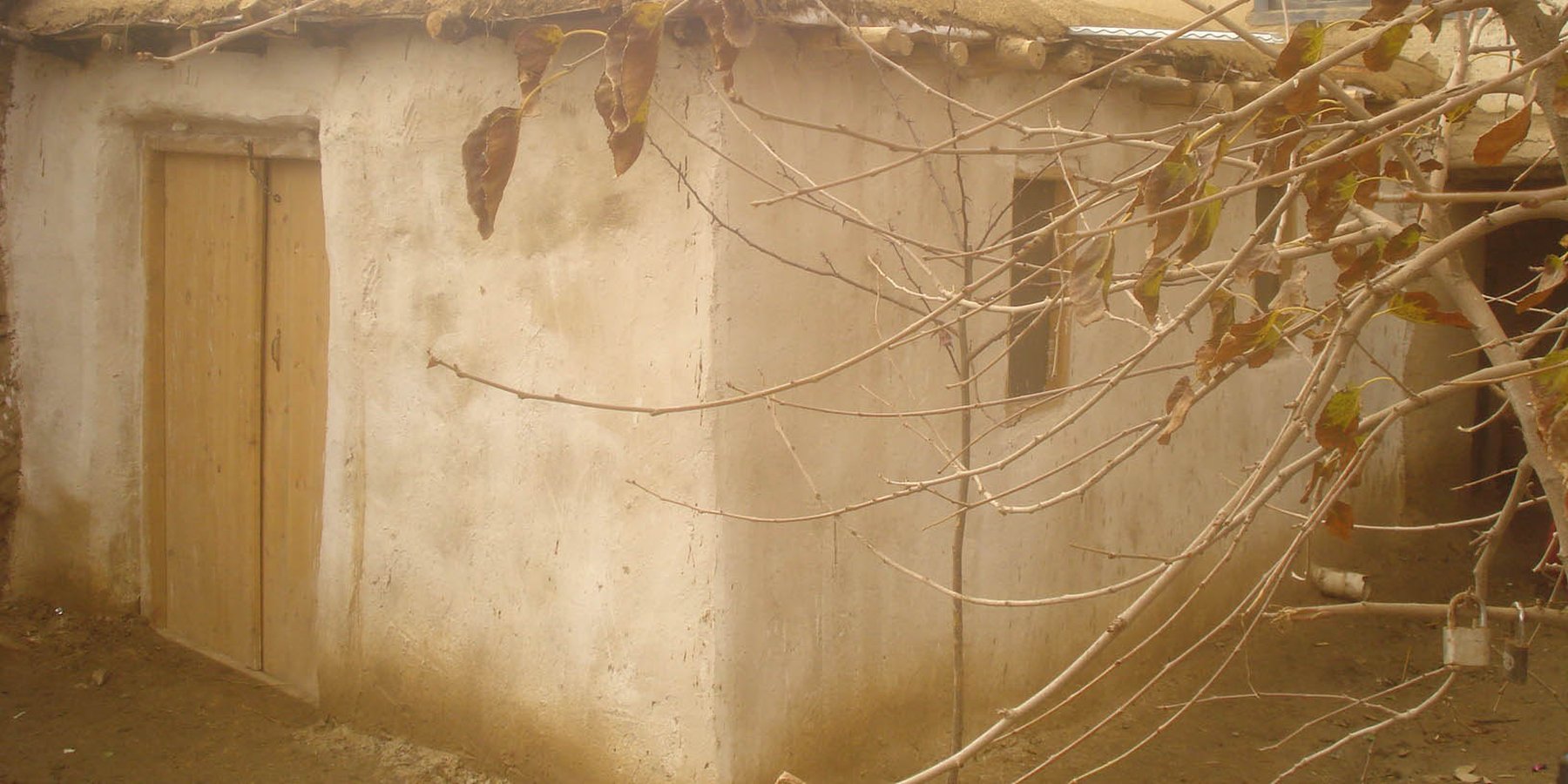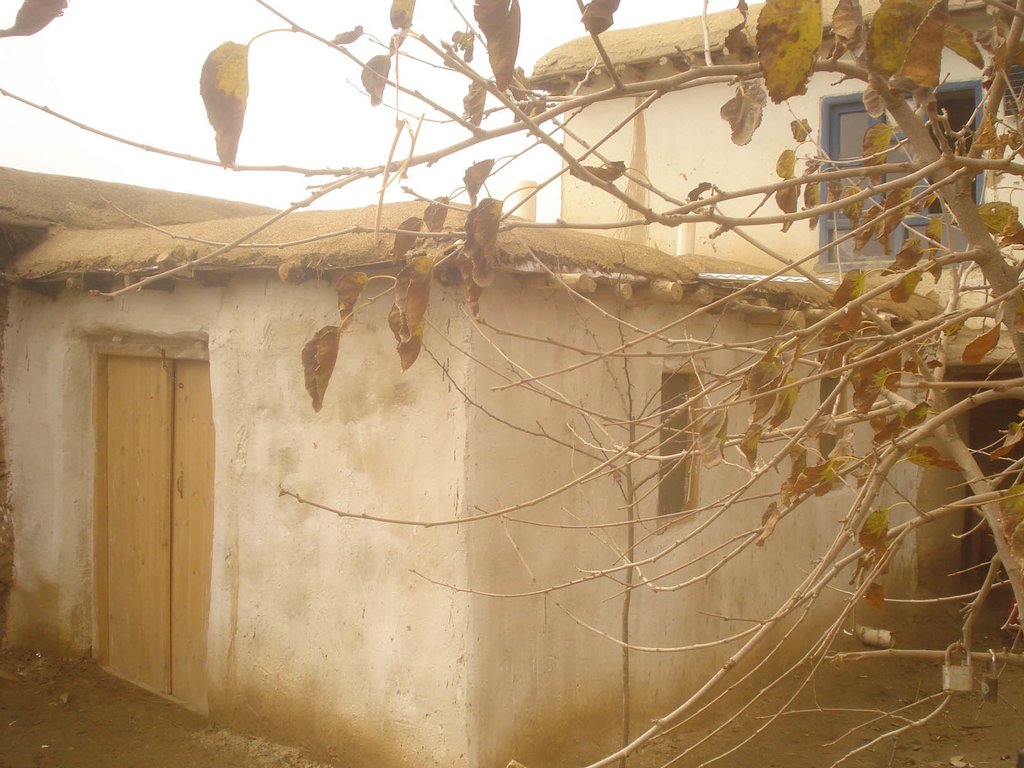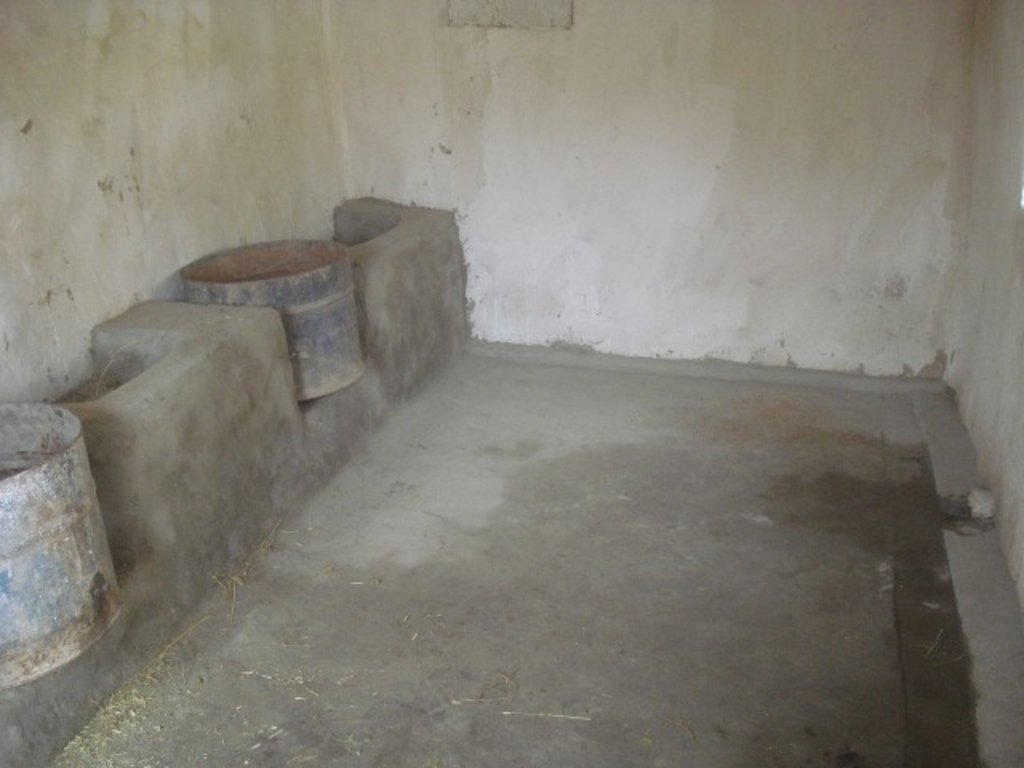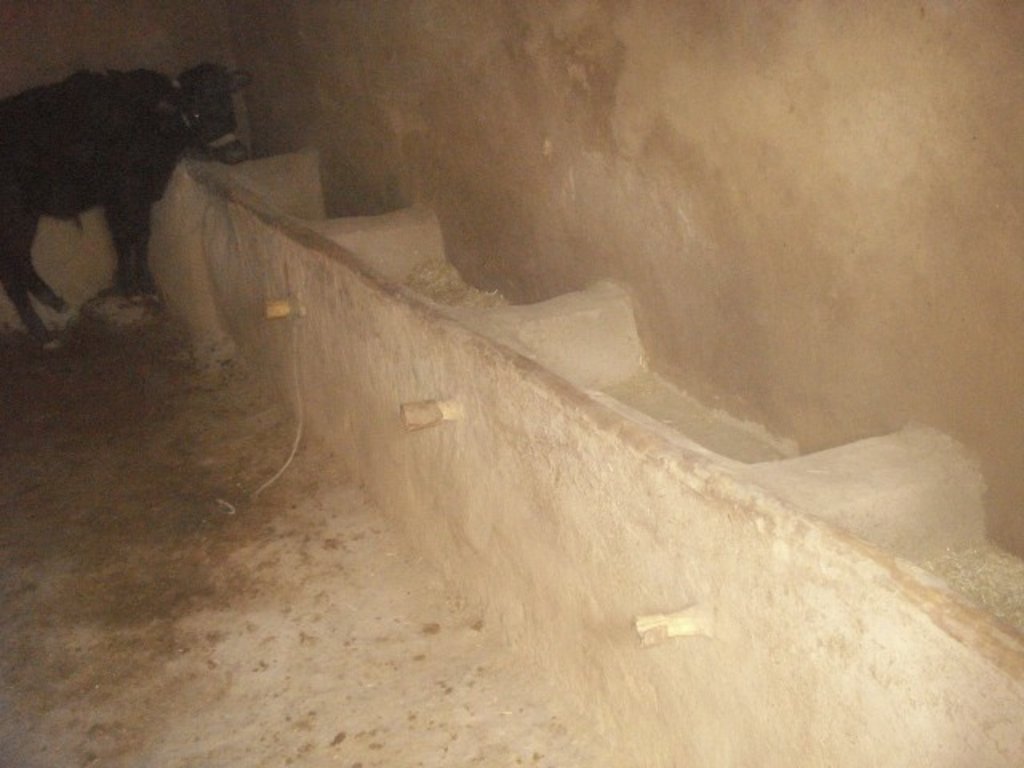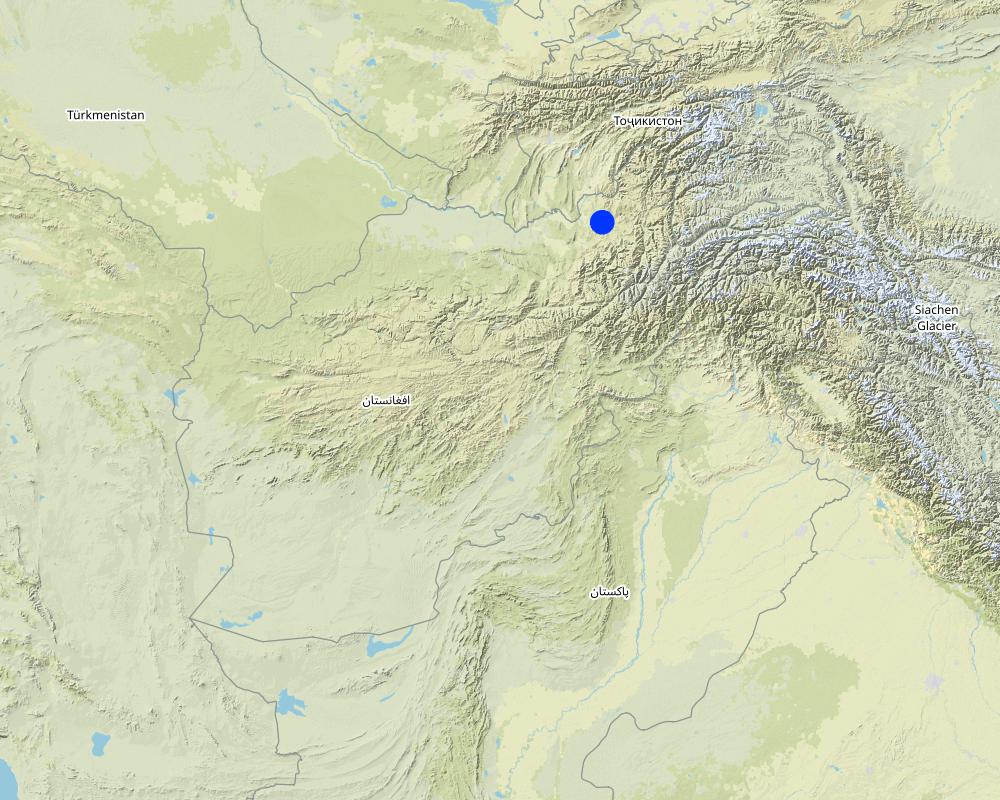Improved livestock shed for better health and productivity [ប្រទេសអាហ្វហ្គានិស្ថាន]
- ការបង្កើត៖
- បច្ចុប្បន្នភាព
- អ្នកចងក្រង៖ Bettina Wolfgramm
- អ្នកកែសម្រួល៖ Miajan Maroofi, Hekmatullah Sharifzai, Roziya Kirgizbekova, Aslam Qadamov
- អ្នកត្រួតពិនិត្យ William Critchley
Tabela; Oghil
technologies_673 - ប្រទេសអាហ្វហ្គានិស្ថាន
ពិនិត្យមើលគ្រប់ផ្នែក
ពង្រីកមើលទាំងអស់ បង្រួមទាំងអស់1. ព័ត៌មានទូទៅ
1.2 ព័ត៌មានលម្អិតពីបុគ្គលសំខាន់ៗ និងស្ថាប័នដែលចូលរួមក្នុងការវាយតម្លៃ និងចងក្រងឯកសារនៃបច្ចេកទេស
Researcher:
អ្នកប្រើប្រាស់ដី:
Alti Boy Sherogha
Natural Resources Management Committee (NRMC)
Sari Joy village, Rustaq District
ប្រទេសអាហ្វហ្គានិស្ថាន
ឈ្មោះគម្រោងដែលបានចងក្រងឯកសារ/ វាយតម្លៃលើបច្ចេកទេស (បើទាក់ទង)
Livelihood Improvement Project Takhar, Afghanistan (LIPT)ឈ្មោះគម្រោងដែលបានចងក្រងឯកសារ/ វាយតម្លៃលើបច្ចេកទេស (បើទាក់ទង)
Potential and limitations for improved natural resource management (NRM) in mountain communities in the Rustaq district, Afghanistan (Rustaq NRM Study)ឈ្មោះអង្គភាពមួយ (ច្រើន) ដែលបានចងក្រងឯកសារ/ វាយតម្លៃបច្ចេកទេស (បើទាក់ទង)
Terre des Hommes (Terre des Hommes) - ប្រទេសស្វ៊ីសឈ្មោះអង្គភាពមួយ (ច្រើន) ដែលបានចងក្រងឯកសារ/ វាយតម្លៃបច្ចេកទេស (បើទាក់ទង)
Swiss Agency for Development and Cooperation (DEZA / COSUDE / DDC / SDC) - ប្រទេសស្វ៊ីសឈ្មោះអង្គភាពមួយ (ច្រើន) ដែលបានចងក្រងឯកសារ/ វាយតម្លៃបច្ចេកទេស (បើទាក់ទង)
CDE Centre for Development and Environment (CDE Centre for Development and Environment) - ប្រទេសស្វ៊ីស1.3 លក្ខខណ្ឌទាក់ទងទៅនឹងការប្រើប្រាស់ទិន្នន័យដែលបានចងក្រងតាមរយៈ វ៉ូខេត
អ្នកចងក្រង និង(បុគ្គលសំខាន់ៗ)យល់ព្រមទទួលយកនូវលក្ខខណ្ឌនានាទាក់ទងទៅនឹងការប្រើប្រាស់ទិន្នន័យដែលបានចងក្រងតាមរយៈវ៉ូខេត:
បាទ/ចា៎
1.4 សេចក្តីប្រកាសស្តីពីចីរភាពនៃការពណ៌នាពីបច្ចេកទេស
តើបច្ចេកទេសដែលបានពណ៌នានេះមានបញ្ហាដែលផ្តោតលើការធ្លាក់ចុះគុណភាពដី, បើដូច្នេះវាមិនអាចត្រូវបានប្រកាសថាជាបច្ចេកទេសនៃការគ្រប់គ្រងប្រកបដោយចីរភាពទេ?
ទេ
មតិយោបល់:
SLM practices documented in the frame of the Rustaq NRM study were established only recently (1-3 years ago). It is too early for a final judgment on the sustainability of these technologies within the human and natural environment of Chokar watershed.
1.5 ការយោងទៅលើកម្រងបញ្ជីសំណួរនៃវិធីសាស្ត្រផ្សព្វផ្សាយ SLM
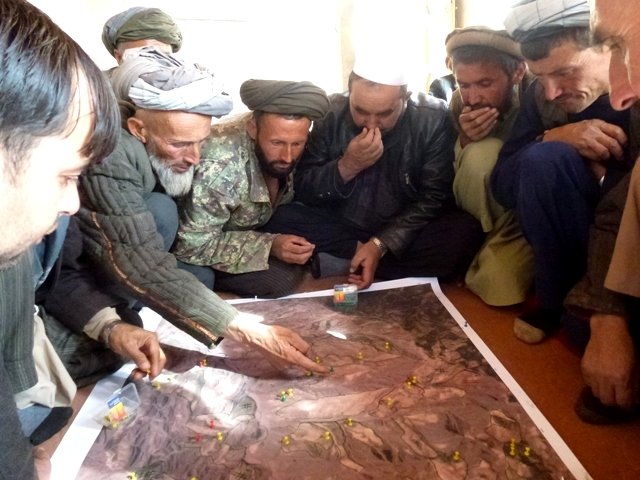
Watershed Associations (WSA) and Natural Resource Management Committees … [ប្រទេសអាហ្វហ្គានិស្ថាន]
Two Watershed Associations (WSA), in Chaker and Nahristan watershed areas respectively, are registered at the national level with the Ministry of Agriculture Irrigation and Livestock (MAIL) and at the regional level with the Department of Agriculture. Both associations are strong, active, dynamic, and have the capacity to coordinate and support …
- អ្នកចងក្រង៖ Bettina Wolfgramm
2. ការពណ៌នាពីបច្ចេកទេស SLM
2.1 ការពណ៌នាដោយសង្ខេបពីបច្ចេកទេស
និយមន័យបច្ចេកទេស:
Existing livestock sheds can be improved through interior and exterior refurbishing, and door and window installation. More favourable indoor conditions benefit animal health and the quality of animal products.
2.2 ការពណ៌នាលម្អិតពីបច្ចេកទេស
ការពណ៌នា:
Livestock keeping is one of the key livelihood strategies in rural Rustaq - in addition to cultivation of agricultural crops. Families rely on their livestock not only for consumption of meat and dairy products, but also as means of transportation (donkeys), labour force in agriculture (oxen, donkeys) and as a source of cash income. When crops fail to produce enough, families sell their livestock to survive until the next season. The pressure to sell livestock is more acute during winter months, when cases of livestock loss increases - from diseases, lack of fodder and the harsh cold winter. These factors, along with poor conditions for livestock keeping, expose the animals to various negative impacts, affecting health, productivity and low quality/ quantity of meat and milk.
This situation is observed mainly in Sari Joy, Jawaz Khana and Dashti Mirzai villages, although Dasthi Mirzai has limited grazing land and livestock keeping is not as prevalent as in the two other villages. All three villages were selected to demonstrate improved livestock sheds, which are among the key factors for productive livestock keeping, along with stable supplies of quality fodder. Improved livestock sheds are part of the chain of activities introduced in the three villages to support livestock production, and at the same time improve the availability and quality of fodder, and restore the degraded and overgrazed pastures.
The Natural Resources Management Committee in the respective villages select a farmer, who is active in livestock keeping and already has a livestock shed. The farmer agrees to provide his livestock shed to serve as a demonstration. The farmer is supported technically and financially to renovate his shed in accordance with the defined requirements. The internal and external walls of the shed are covered with plaster made from a clay mixture to block all holes and protect the building from wind and rain. The roof is renovated to prevent leaking from snow and rain. Windows, a door and a ventilator are installed to ensure air circulation, decrease humidity levels, and protect the animals from cold and heat. A water trough and feeding racks are installed inside the shed. All the costs for the material are covered by the project. The farmer contributes with his labour.
The improved shed is vital for keeping livestock healthy. It also contributes to lowering livestock loss through decreasing the risks of diseases and cold stress during winter. The overall benefit towards livelihoods is significant, since animals are an important household asset and a coping strategy for the majority of households in the villages. The wives of the farmers benefit particularly from the renovated livestock sheds, because they are the ones who feed and water the animals, and they clean the shed of manure.
However, the costs for carrying out renovation of livestock sheds are perceived too high by the farmers. Many are unwilling to make such investments, despite the benefits.
2.3 រូបភាពនៃបច្ចេកទេស
2.5 ប្រទេស/តំបន់/ទីតាំងកន្លែង ដែលបច្ចេកទេសត្រូវបានអនុវត្ត និងបានគ្រប់ដណ្តប់ដោយការវាយតម្លៃនេះ
ប្រទេស:
ប្រទេសអាហ្វហ្គានិស្ថាន
តំបន់/រដ្ឋ/ខេត្ត:
Takhar Province, Rustaq District
បញ្ជាក់បន្ថែមពីលក្ខណៈនៃទីតាំង:
Sari Joy, Jawaz Khana, Dashti Mirzai villages
មតិយោបល់:
Coordinates of SLM plots owned by SLM implementers who participated in the FGD derived through the Rustaq NRM study QGIS database.
This documentation is based on the experiences of SLM implementers from Sari Joy (1 Livestock shed), Jawaz Khana (1 Livestock shed) and Dashti Mirzai (1 Livestock shed).
Map
×2.6 កាលបរិច្ឆេទនៃការអនុវត្ត
បង្ហាញឆ្នាំនៃការចុះអនុវត្ត:
2014
ប្រសិនបើមិនច្បាស់ឆ្នាំ សូមបញ្ជាក់កាលបរិច្ឆេទដែលប្រហាក់ប្រហែល:
- តិចជាង 10ឆ្នាំមុន (ថ្មី)
2.7 ការណែនាំពីបច្ចេកទេស
សូមបញ្ជាក់តើបច្ចេកទេសត្រូវបានណែនាំឱ្យអនុវត្តដោយរបៀបណា:
- តាមរយៈគម្រោង / អន្តរាគមន៍ពីខាងក្រៅ
មតិយោបល់ (ប្រភេទនៃគម្រោង ។ល។):
Livelihood Improvement Project Takhar (LIPT) supported by Swiss Development Cooperation (SDC) from 2012-17
3. ចំណាត់ថ្នាក់នៃបច្ចេកទេស SLM
3.1 គោលបំណងចម្បង (១ ឬច្រើន) នៃបច្ចេកទេសនេះ
- improve animal health
3.2 ប្រភេទដីប្រើប្រាស់មួយប្រភេទ (ច្រើនប្រភេទ) ដែលបានអនុវត្តបច្ចេកទេស

លំនៅដ្ឋាន ហេដ្ឋារចនាសម្ព័ន្ធ
- ដីលំនៅស្ថាន អគារ
កំណត់សម្គាល់:
Livestock shed, cows, sheep, goats
3.4 ក្រុម SLM ដែលបច្ចេកទេសស្ថិតនៅក្នុង
- កសិរុក្ខកម្ម (pastoralism) និងការគ្រប់គ្រងដីសម្រាប់ចិញ្ចឹមសត្វ
- Livestock management
3.5 ការសាយភាយនៃបច្ចេកទេស
បញ្ជាក់ពីការសាយភាយនៃបច្ចេកទេស:
- អនុវត្តនៅកន្លែងជាក់លាក់មួយ/ ប្រមូលផ្តុំនៅតំបន់តូចៗ
3.6 វិធានការ SLM ដែលបញ្ចូលនូវបច្ចេកទេស

វិធានការរចនាស័ម្ពន្ធ
- S9: រោងដំណាំ និងរោងចិញ្ចឹមសត្វ
3.8 ការពារ កាត់បន្ថយ ឬស្តារឡើងវិញនៃការធ្លាក់ចុះគុណភាពដី
បញ្ជាក់ពីគោលដៅរបស់បច្ចេកទេស ដែលផ្តោតទៅការធ្លាក់ចុះគុណភាពដី:
- ដែលមិនអាចអនុវត្តបាន
4. បច្ចេកទេសជាក់លាក់ សកម្មភាពអនុវត្ត ធាតុចូល និងថ្លៃដើម
4.2 លក្ខណៈពិសេសនៃបច្ចេកទេស/ ពណ៌នាពីគំនូរបច្ចេកទេស
The size of an improved livestock shed is 5 m x 3 m. The internal and external walls of the shed are covered with plaster made from a clay mixture to block all the holes and protect the building from the external elements of rain and wind. The roof is renovated to prevent leaking from snow and rain. Two windows, sized 60 cm x 30 cm and an entrance door 1.5 m x 2 m are installed. 3 ventilation pipes are installed on the roof. The installation of windows, entrance door and ventilators ensure air circulation, decrease humidity levels and protect the animals from cold winters and hot summers. A water trough and feeding racks are installed inside the shed. All the costs for the material are covered by the project. The farmer contributes through labour.
4.3 ព័ត៌មានទូទៅដែលពាក់ព័ន្ធនឹងការគណនាធាតុចូល និងថ្លៃដើម
កំណត់របៀបនៃការគណនាថ្លៃដើម និងធាតុចូល:
- ក្នុងឯកតាបច្ចេកទេស
បញ្ជាក់ឯកតា:
Building of the livestock shed
បញ្ជាក់ទំហំ ប្រវែង ។ល។ (បើពាក់ព័ន្ធ):
5m x 3m
កំណត់រូបិយប័ណ្ណសម្រាប់ថ្លៃដើម:
- ដុល្លារអាមេរិក
កំណត់អត្រាប្តូរប្រាក់ពីដុល្លាទៅរូបិយប័ណ្ណតំបន់ (បើទាក់ទង)៖ 1 ដុល្លារ =:
67,0
កំណត់ថ្លៃឈ្នួលជាមធ្យមនៃការជួលកម្លាំងពលកម្មក្នុងមួយថ្ងៃ:
5.2-5.3 USD
4.4 សកម្មភាពបង្កើត
| សកម្មភាព | ប្រភេទវិធានការ | ពេលវេលា | |
|---|---|---|---|
| 1. | Selection and inspection of the livestock shed for referbishing | ការគ្រប់គ្រង | |
| 2. | Design of measures for referbishment | ការគ្រប់គ្រង | |
| 3. | Transportation of construction materials | ផ្សេងៗ | |
| 4. | Covering the internal and external walls with plaster | រចនាសម្ព័ន្ធ | |
| 5. | Installation of doors and windows | រចនាសម្ព័ន្ធ | |
| 6. | Installation of feed racks, water trough and ventilator | រចនាសម្ព័ន្ធ |
4.5 ថ្លៃដើម និងធាតុចូលដែលត្រូវការសម្រាប់ការបង្កើតបច្ចេកទេស
| បញ្ជាក់ពីធាតុចូល | ឯកតា | បរិមាណ | ថ្លៃដើមក្នុងមួយឯកតា | ថ្លៃធាតុចូលសរុប | % នៃថ្លៃដើមដែលចំណាយដោយអ្នកប្រើប្រាស់ដី | |
|---|---|---|---|---|---|---|
| កម្លាំងពលកម្ម | Transportation of construction materials | person-day | 1,0 | 52,0 | 52,0 | |
| កម្លាំងពលកម្ម | Preparation works | person-day | 2,0 | 5,3 | 10,6 | |
| កម្លាំងពលកម្ម | Rennovation works (doors, windows, water tanker and feed slot) | person-day | 14,0 | 5,3 | 74,2 | 100,0 |
| សម្ភារៈសាងសង់ | Pipe for air ventilation | piece | 3,0 | 7,4 | 22,2 | |
| សម្ភារៈសាងសង់ | Lime | Bag | 1,0 | 14,0 | 14,0 | |
| សម្ភារៈសាងសង់ | Cement | Bag | 10,0 | 5,2 | 52,0 | |
| សម្ភារៈសាងសង់ | Door | piece | 1,0 | 59,0 | 59,0 | |
| សម្ភារៈសាងសង់ | Window | piece | 2,0 | 22,0 | 44,0 | |
| សម្ភារៈសាងសង់ | Cloth | Meter | 12,0 | 1,8 | 21,6 | |
| ផ្សេងៗ | Water tank for animals | piece | 2,0 | 8,9 | 17,8 | |
| ថ្លៃដើមសរុបក្នុងការបង្កើតបច្ចេកទេស | 367,4 | |||||
ប្រសិនបើអ្នកប្រើប្រាស់ដីមិនមានថ្លៃដើម 100% សូមបញ្ជាក់ថានរណាដែលចំណាយថ្លៃដើមដែលនៅសល់:
Livelihood Improvement Project Takhar (LIPT) implemented by Terre des hommes (Tdh) Switzerland
4.6 សកម្មភាពថែទាំ
| សកម្មភាព | ប្រភេទវិធានការ | ពេលវេលា/ ភាពញឹកញាប់ | |
|---|---|---|---|
| 1. | Repair of the roof with clay | រចនាសម្ព័ន្ធ | Autumn |
4.7 កំណត់ថ្លៃដើមសម្រាប់ការថែទាំ/ សកម្មភាពរបស់បច្ចេកទេស (ក្នុងរយៈពេលមួយឆ្នាំ)
| បញ្ជាក់ពីធាតុចូល | ឯកតា | បរិមាណ | ថ្លៃដើមក្នុងមួយឯកតា | ថ្លៃធាតុចូលសរុប | % នៃថ្លៃដើមដែលចំណាយដោយអ្នកប្រើប្រាស់ដី | |
|---|---|---|---|---|---|---|
| កម្លាំងពលកម្ម | Repair of the roof | person day | 2,0 | 5,3 | 10,6 | 100,0 |
| ថ្លៃដើមសរុបសម្រាប់ការថែទាំដំណាំតាមបច្ចេកទេស | 10,6 | |||||
4.8 កត្តាសំខាន់បំផុតដែលមានឥទ្ធិពលដល់ការចំណាយ
ពណ៌នាពីកត្តាប៉ះពាល់ចម្បងៗទៅលើថ្លៃដើម:
Due to the remoteness of the villages where the technology has been implemented, all the inputs for establishment, such as agricultural equipment, plant material, fertilizers, etc., are purchased in Rustaq town. The expenses for traveling and delivering the inputs affect the establishment costs.
5. លក្ខណៈបរិស្ថានធម្មជាតិ និងមនុស្ស
5.1 អាកាសធាតុ
បរិមាណទឹកភ្លៀងប្រចាំឆ្នាំ
- < 250 មម
- 251-500 មម
- 501-750 មម
- 751-1,000 មម
- 1,001-1,500 មម
- 1,501-2,000 មម
- 2,001-3,000 មម
- 3,001-4,000 មម
- > 4,000 មម
កំណត់បរិមាណទឹកភ្លៀង (បើដឹង) ជា មីលីម៉ែត្រ:
580,00
លក្ខណៈពិសេស/ មតិយោបល់លើរដូវភ្លៀង:
Average annual precipitation for the area was calculated as 580 mm, with minimum in dry years (2000 and 2001) of 270 mm and maximum in wet years (2009/2010) of 830 mm. The absolute maximum rainfall was calculated for 1986 as 1024 mm. The data series covers the period from 1979 to 2014.
បញ្ជាក់ឈ្មោះឯកសារយោងនៃស្ថានីយឧតុនិយម:
Reference meteorological station considered: Climate Forecast System Reanalysis (CFSR), http://rda.ucar.edu/pub/cfsr.html
តំបន់កសិអាកាសធាតុ
- មានភ្លៀងតិចតួច
Derived from the publicly available data set on length of growing period (LGP) (Fischer 2009 / IIASA-FAO). Internet link: http://tiles.arcgis.com/tiles/P8Cok4qAP1sTVE59/arcgis/rest/services/Length_of_growing_period/MapServer
5.2 សណ្ឋានដី
ជម្រាលជាមធ្យម:
- រាបស្មើ (0-2%)
- ជម្រាលតិចតួច (3-5%)
- មធ្យម (6-10%)
- ជម្រាលខ្ពស់បន្តិច (11-15%)
- ទីទួល (16-30%)
- ទីទួលចោត (31-60%)
- ទីទួលចោតខ្លាំង (>60%)
ទម្រង់ដី:
- ខ្ពង់រាប
- កំពូលភ្នំ
- ជម្រាលភ្នំ
- ជម្រាលទួល
- ជម្រាលជើងភ្នំ
- បាតជ្រលងភ្នំ
តំបន់តាមរយៈកម្ពស់ :
- 0-100 ម
- 101-500 ម
- 501-1,000 ម
- 1,001-1,500 ម
- 1,501-2,000 ម
- 2,001-2,500 ម
- 2,501-3,000 ម
- 3,001-4,000 ម
- > 4,000 ម
5.4 ទឹកដែលអាចទាញមកប្រើប្រាស់បាន និងគុណភាពទឹក
នីវ៉ូទឹកក្រោមដី:
5-50 ម
ទឹកលើដីដែលអាចទាញយកប្រើប្រាស់បាន:
កម្រិតមធ្យម
គុណភាពទឹក (មិនបានធ្វើប្រត្តិកម្ម):
ទឹកពិសារដែលមានគុណភាពល្អ
តើមានបញ្ហាភាពទឹកប្រៃហូរចូលមកដែរឬទេ?
ទេ
តើទឹកជំនន់កំពុងកើតមាននៅតំបន់នេះដែររឺទេ?
បាទ/ចា៎
ភាពទៀងទាត់:
ម្តងម្កាល
មតិយោបល់ និងលក្ខណៈពិសេសផ្សេងៗទៀតលើគុណភាព និងបរិមាណទឹក :
Floods occur mainly during the rainy seasons in spring and autumn. Availability of surface water differs for the three study villages Sari Joy, Jawaz Khana, and Dashti Mirzai. Sari Joy has sources and good surface water availability. Jawaz Khana has poor water availability as water has to be fetched from a low lying stream. Dashti Mirzai has good water availability also from an irrigation channel.
5.5 ជីវៈចម្រុះ
ភាពសម្បូរបែបនៃប្រភេទ:
- ទាប
ភាពសម្បូរបែបនៃទីជម្រក:
- ទាប
5.6 លក្ខណៈនៃអ្នកប្រើប្រាស់ដីដែលអនុវត្តបច្ចេកទេស
នៅមួយកន្លែង ឬពនេចរ :
- ពាក់កណ្តាលពនេចរ
ទីផ្សារនៃប្រព័ន្ធផលិតកម្ម:
- ពាក់កណ្តាលពាណិជ្ជកម្ម (ផ្គត់ផ្គង់ខ្លួនឯង/ ពាណិជ្ជកម្ម
ចំណូលក្រៅកសិកម្ម:
- 10-50% នៃចំណូល
កម្រិតជីវភាព:
- មាន
ឯកជន ឬក្រុម:
- ធ្វើខ្លួនឯង/ គ្រួសារ
កម្រិតប្រើប្រាស់គ្រឿងយន្ត:
- ប្រើកម្លាំងពលកម្ម
យេនឌ័រ:
- ស្ត្រី
- បុរស
អាយុរបស់អ្នកប្រើប្រាស់ដី:
- វ័យកណ្តាល
- មនុស្សចាស់
សូមបញ្ជាក់ពីលក្ខណៈពាក់ព័ន្ធផ្សេងទៀតអំពីអ្នកប្រើប្រាស់ដី:
Source: Based on the data collected by CDE and HAFL.
Technology is applied belong to the Uzbek ethnic minority group Qarluq.
Although the men are generally the main land users, , women and children also take active part in the related work. The functions of men and women are clearly distinguished within the Afghan society. At the same time within the family this division of work and functions also results in men and women working hand-in-hand. An improvement of the family’s livelihood situation is expected to positively affect all family members. While, it is recognized that the involvement of women is key in order to secure basic human rights for everyone, to achieve good governance, sustainable development, and to efficiently contribute to poverty reduction (SDC 2004), it is also clear that a context sensitive approach is of great importance.
Women in rural Afghanistan are involved in many production and income generating activities that contribute to the overall household income. However, very few women own resources such as land and livestock, and their income generating options are fewer in comparison to that of men.
5.7 ទំហំផ្ទៃដីជាមធ្យមនៃដីផ្ទាល់ខ្លួន ឬជួលគេដែលបានអនុវត្តបច្ចេកទេស
- < 0.5 ហិកតា
- 0.5-1 ហិកតា
- 1-2 ហិកតា
- 2-5 ហិកតា
- 5-15 ហិកតា
- 15-50 ហិកតា
- 50-100 ហិកតា
- 100-500 ហិកតា
- 500-1,000 ហិកតា
- 1,000-10,000 ហិកតា
- > 10,000 ហិកតា
តើផ្ទៃដីនេះចាត់ទុកជាទំហំកម្រិតណាដែរ ខ្នាតតូច មធ្យម ឬខ្នាតធំ (ធៀបនឹងបរិបទតំបន់)?
- ខ្នាតមធ្យម
5.8 ភាពជាម្ចាស់ដី កម្មសិទ្ធប្រើប្រាស់ដី និងកម្មសិទ្ធប្រើប្រាស់ទឹក
ភាពជាម្ចាស់ដី:
- ឯកជន មិនមានកម្មសិទ្ធ
កម្មសិទ្ធិប្រើប្រាស់ដី:
- ឯកជន
កម្មសិទ្ធប្រើប្រាស់ទឹក:
- ជាក្រុម (មានដែនកំណត់)
មតិយោបល់:
Those who own land and use water for irrigation are obliged to pay for the water. The payment is made both in kind and in cash to the Mirob, the person in charge of distributing water in the community. The amount of the payment varies from village to village.
5.9 ការប្រើប្រាស់សេវាកម្ម និងហេដ្ឋារចនាសម្ព័ន្ធ
សុខភាព:
- មិនល្អ
- មធ្យម
- ល្អ
ការអប់រំ:
- មិនល្អ
- មធ្យម
- ល្អ
ជំនួយបច្ចេកទេស:
- មិនល្អ
- មធ្យម
- ល្អ
ការងារ (ឧ. ការងារក្រៅកសិដ្ឋាន):
- មិនល្អ
- មធ្យម
- ល្អ
ទីផ្សារ:
- មិនល្អ
- មធ្យម
- ល្អ
ថាមពល:
- មិនល្អ
- មធ្យម
- ល្អ
ផ្លូវ និងការដឹកជញ្ជូន:
- មិនល្អ
- មធ្យម
- ល្អ
ទឹកផឹក និងអនាម័យ:
- មិនល្អ
- មធ្យម
- ល្អ
សេវាកម្មហិរញ្ញវត្ថុ:
- មិនល្អ
- មធ្យម
- ល្អ
6. ផលប៉ះពាល់ និងការសន្និដ្ឋាន
6.1 ផលប៉ះពាល់ក្នុងបរិវេណអនុវត្តបច្ចេកទេសដែលកើតមាន
ផលប៉ះពាល់លើសេដ្ឋកិច្ចសង្គម
ផលិតផល
ផលិតកម្មចំណីសត្វ
ផលិតកម្មសត្វ
អនុផលព្រៃឈើ
ភាពសម្បូរបែបនៃផលិតផល
ផ្ទៃដីផលិតកម្ម
ផលប៉ះពាល់ទៅលើវប្បធម៌សង្គម
ចំណេះដឹង SLM / ការធ្លាក់ចុះគុណភាពដី
មតិយោបល់/ ការបញ្ជាក់:
Land users learned how to implement SLM practices.
ស្ថានភាពក្រុមដែលមានបញ្ហាក្នុងសង្គម និងសេដ្ឋកិច្ច
មតិយោបល់/ ការបញ្ជាក់:
Female headed households are not included. Technology is implemented on private land, therefore people without land are excluded. However, they have the opportunity to earn income as a hired worker for the SLM implementers.
6.2 ផលប៉ះពាល់ក្រៅបរិវេណអនុវត្តបច្ចេកទេសដែលកើតមាន
បញ្ជាក់បន្ថែមការវាយតម្លៃផលប៉ះពាល់:
These comments apply to 6.1:
- Socio-economic impacts: Individual SLM implementers were asked to rate the benefits from the technology. They were asked to indicate production increase of crops; fodder; animals; wood; non-wood forest products; increase in product diversity; or production area. The most important increase they rated with 3, the second most with 2, others with 1 point. Averages of the points given by all terrace implementers are reflected here.
Ecological impacts and off-site impacts: Based on the Land User Protocols: Individual SLM implementers were asked to rate the on-site and off-site impacts of the Technology on water; soil; and vegetation. They were asked to indicate the strength of impacts with three, two or one points. Averages of the points given by all implementers are reflected here.
6.3 ភាពប្រឈម និងភាពរួសនៃបច្ចេកទេសទៅនឹងការប្រែប្រួលអាកាសធាតុ និងគ្រោះអាកាសធាតុ/ គ្រោះមហន្តរាយ (ដែលដឹងដោយអ្នកប្រើប្រាស់ដី)
គ្រោះអាកាសធាតុ (មហន្តរាយ)
គ្រោះមហន្តរាយធម្មជាតិ
| លក្ខណៈឆ្លើយតបនៃបច្ចេកទេសទៅនឹងការប្រែប្រួលអាកាសធាតុ | |
|---|---|
| ព្យុះភ្លៀងតាមតំបន់ | ល្អណាស់ |
គ្រោះមហន្តរាយអាកាសធាតុ
| លក្ខណៈឆ្លើយតបនៃបច្ចេកទេសទៅនឹងការប្រែប្រួលអាកាសធាតុ | |
|---|---|
| រាំងស្ងួត | ល្អណាស់ |
មតិយោបល់:
SLM implementers from three villages were asked to jointly discuss and rate how much the SLM technology reduced the lands vulnerability to drought and local rainstorms. Only vulnerability to the most prevalent climate extremes (drought and local rainstorms) was discussed. SLM technologies were rated as reducing vulnerability poorly , well, or very well. The average points reflected here are from multi-criteria matrices compiled in three villages where the SLM technology had been implemented.
6.4 ការវិភាគថ្លៃដើម និងអត្ថប្រយោជន៍
តើផលចំណេញ និងថ្លៃដើមត្រូវបានប្រៀបធៀបគ្នាយ៉ាងដូចម្តេច (ទស្សនៈរបស់អ្នកប្រើប្រាស់ដី)?
រយៈពេលខ្លី:
វិជ្ជមានខ្លាំង
រយៈពេលវែង:
វិជ្ជមានខ្លាំង
មតិយោបល់:
Based on the multi-criteria matrix: During the FGD with SLM implementers, a multi-criteria matrix was elaborated, and different SLM practices were rated. In the frame of this exercise, SLM implementers were asked to jointly discuss and rate short term (1-3 years) and long-term (10 years) returns. As the SLM technology was only implemented 1-2 years ago, it is too early to compare benefits to maintenance costs. Farmers have little experience so far on the actual benefits of the SLM technology. The ratings are mostly based on expected benefits and not on actual benefits.
6.5 ការទទួលយកបច្ចេកទេស
- តែមួយករណី /ពិសោធន៍
បើអាច សូមបញ្ជាក់ពីបរិមាណ (ចំនួនគ្រួសារ និង/ ឬតំបន់គ្របដណ្តប់):
3 households took part in implementing the Technology
មតិយោបល់:
Based on the Land User Protocol: Individual SLM implementers were asked whether they received support for implementing the Technology. Each indicated the type of support he received from the proposed options: "Full Support 100%, Some Support, No Support 0%".
6.6 ការបន្សុំា
តើថ្មីៗនេះ បច្ចេកទេសនេះត្រូវបានកែតម្រូវដើម្បីបន្ស៊ាំទៅនឹងស្ថានភាពប្រែប្រួលដែរឬទេ?
ទេ
6.7 ភាពខ្លាំង/ គុណសម្បត្តិ/ ឱកាសនៃបច្ចេកទេស
| ភាពខ្លាំង/ គុណសម្បត្តិ/ ឱកាសនៅកន្លែងរបស់អ្នកប្រើប្រាស់ដី |
|---|
| The animals are protected from severe cold weather during the winter. The ventilation is good for keeping the air clean inside the livestock shelter. |
| Lower risks of animal diseases. |
| ភាពខ្លាំង/ គុណសម្បត្តិ/ ឱកាស ទស្សនៈរបស់បុគ្គលសំខាន់ៗ |
|---|
| Improved facility, proper feeding and and watering could reduce diseases and enhance the quality of meat and milk. |
| The survival of livestock may increase potentially, particularly losses may decrease during winter. |
6.8 ភាពខ្សោយ/ គុណវិបត្តិ/ ហានិភ័យនៃបច្ចេកទេស និងវិធីសាស្ត្រដោះស្រាយ
| ភាពខ្សោយ/ គុណវិបត្តិ/ ហានិភ័យ ទស្សនៈរបស់អ្នកប្រើប្រាស់ដី | តើបច្ចេកទេសទាំងនោះបានដោះស្រាយបញ្ហាដូចម្តេច? |
|---|---|
| Renovation works are too costly and many farmers cannot afford to purchase all the construction material |
| ភាពខ្សោយ/ គុណវិបត្តិ/ ហានិភ័យ ទស្សនៈរបស់អ្នកចងក្រងឬបុគ្គលសំខាន់ៗ | តើបច្ចេកទេសទាំងនោះបានដោះស្រាយបញ្ហាដូចម្តេច? |
|---|---|
| Due to high establishment costs the practice is less likely to spread among the land users and will remain experimental. |
7. ឯកសារយោង និងវេបសាយ
7.1 វិធីសាស្ត្រ/ ប្រភពនៃព័ត៌មាន
- ការសម្ភាសន៍ជាមួយអ្នកប្រើប្រាស់ដី
Focus group discussions (FGD) were organized to collect information from SLM implementers in Sari Joy, Jawaz Khana and Dashti Mirzai.
- ការសម្ភាសន៍ជាមួយអ្នកជំនាញ/ ឯកទេស
Close collaboration took place during the compilation of this material with the technical staff of the LIPT project in Rustaq.
- ការចងក្រងពីរបាកការណ៍ និងឯកសារផ្សេងៗទៀតដែលមាន
Information provided in the reports of Tdh LIPT Project in Rustaq served as an initial source of information during the preparatory phase and also solidifying the description of the technology and area of implementation. Other background papers on Afghanistan were referred to for general information on agriculture and natural resource management in Afghanistan.
7.2 ឯកសារយោងដែលបានចេញផ្សាយ
ចំណងជើង អ្នកនិពន្ធ ឆ្នាំ ISBN:
Guidelines for Focus Group Discussions
ចំណងជើង អ្នកនិពន្ធ ឆ្នាំ ISBN:
Methods section of the Rustaq NRM study
ការតភ្ជាប់ និងម៉ូឌុល
ពង្រីកមើលទាំងអស់ បង្រួមទាំងអស់ការតភ្ជាប់

Watershed Associations (WSA) and Natural Resource Management Committees … [ប្រទេសអាហ្វហ្គានិស្ថាន]
Two Watershed Associations (WSA), in Chaker and Nahristan watershed areas respectively, are registered at the national level with the Ministry of Agriculture Irrigation and Livestock (MAIL) and at the regional level with the Department of Agriculture. Both associations are strong, active, dynamic, and have the capacity to coordinate and support …
- អ្នកចងក្រង៖ Bettina Wolfgramm
ម៉ូឌុល
គ្មានម៉ូឌុល


